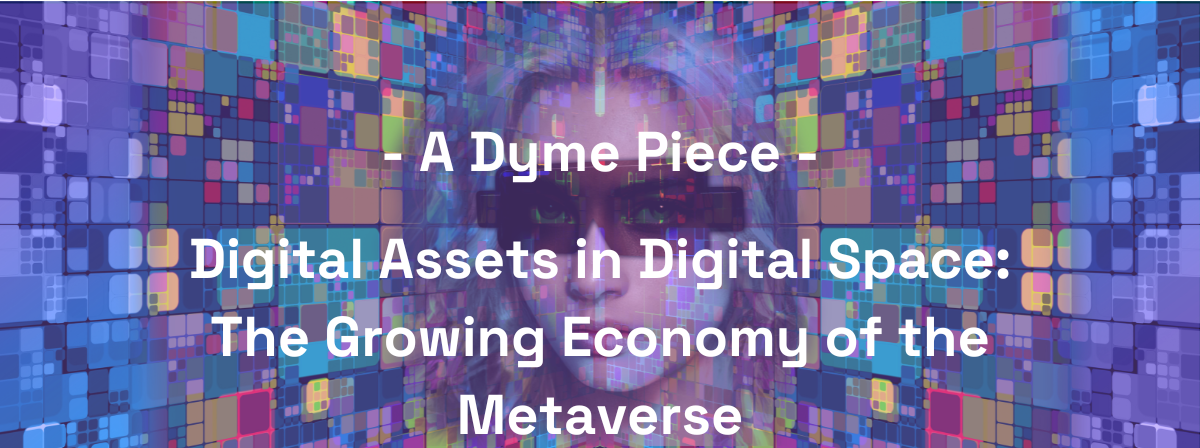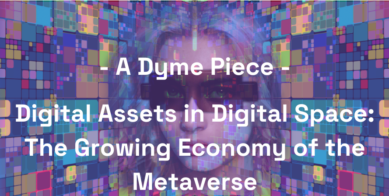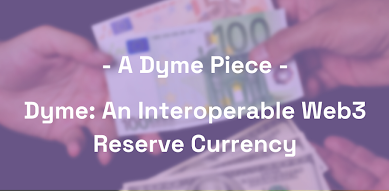In recent years, the line between what is real and what is digital has become increasingly blurred. With the rise of virtual reality, we can now interact with digital environments as if they were physical spaces. Even more, augmented reality lets us blend the physical world with virtual worlds and interact with both at the same time. This fascinating new frontier is called the metaverse.
Similar to the physical world, the virtual world of the metaverse has an economy to facilitate ownership and exchange of value. The developing digital economy around these activities is present in the immersive virtual worlds created by metaverse technologies like augmented reality and virtual reality.
What is the Metaverse? A quick primer
The metaverse is a persistent, online world where users interact with each other and with digital content. Built by tech giants and smaller tech companies, multiple technologies and multiple platforms make up the fabric of the metaverse.
They may use a virtual reality headset to interact in virtual reality or blend the physical world with digital space using augmented reality glasses. While the term metaverse is singular, many virtual worlds make up the metaverse, and many technology companies are engaged in rapid metaverse development. This means that the virtual experiences of tomorrow are almost certainly going to be different than those from yesterday.
The metaverse may be the next iteration of the internet. Metaverse technology is unlikely to replace the internet, and the real world doesn’t bear any risk of being abandoned. The idea of extended reality is a likely outcome, which blends virtual objects with real-world physical space.
Virtual reality and the metaverse
Today, virtual reality (VR) consists of 3D virtual environments accessed through simulations or virtual reality headsets such as Oculus Rift. These virtual worlds are populated by digital avatars that represent users from around the world.
Avatars may be digital twins of the user in real life or be unique digital humans, depending on the designer’s intent for the virtual environment. Neal Stephenson’s 1992 cyberpunk novel Snow Crash popularized avatars as online virtual bodies. (Spoiler alert: that’s the same book that first used the term metaverse in the way we use it today.)
Digital avatars were first seen in the 1979 PLATO role-playing video game Avatar. Virtual avatars have been part of game developers’ work on computer games, on game consoles, and to a lesser extent, in mobile gaming.
So while using a VR headset is the most common example of virtual reality, game developers have used personalized avatars for years to create a bond between an in-game character and the real-world user controlling them.
Augmented reality: the blending of digital spaces and the real world to create an extended reality
Augmented reality is another space where tech giants have spent vast R&D budgets. Where the VR headset built by Meta was the example above, Google’s Google Glass is an example of augmented reality developed by the tech industry.
Augmented reality experiences go well beyond wearables. If you buy a Yeti cooler, you can use your iPhone to place a 3d virtual cooler on the car seat where you want it to see if it fits. You can place virtual furniture in a room and see it using your tablet. The business models for augmented reality are already being tested and are flourishing in unexpected areas of the economy. (Honestly, did you imagine Ethan Allen was going to be mentioned in a metaverse article?)
Spatial computing and advanced camera technology enabled Ethan Allen and Yeti to benefit from AR. It made significant advances in augmented reality and crafting a higher fidelity virtual reality experience. In many ways, early mainstream success is seen in these uses, and the metaverse presents an exciting area of growth for the future.
Other realities: Video games, game consoles, mobile phones
The Meta Platforms video game Horizon Worlds exemplifies social interaction in virtual reality. Players move and interact with each other in various worlds that host events, games, and social activities. Digital worlds — such as aspects of Fortnite that can be accessed through PCs, consoles, and even phones — have started referring to themselves as “the metaverse.”
Video games, in general, have become more open-world and more immersive — two core elements of any virtual world. The social connection in the game persists outside the game, blending the worlds. What is more metaverse than that?
Where does the word Metaverse come from?
The metaverse term originated in Snow Crash, a 1992 science fiction novel by the American writer Neal Stephenson. The 2003 virtual world platform (and video game) Second Life is often described as the first metaverse, as it incorporated many aspects of social media into a persistent virtual world with the user represented as an avatar.
Virtual reality was first used in a 1938 essay by French poet and playwright Antonin Artaud, long before computers or the internet. Similarly, cyberspace was first used in the late 1960s by Danish artist Susanne Ussing. Both terms have come to align with a computer-generated shared virtual space, and thus the three terms, metaverse, virtual reality, and cyberspace, are often used interchangeably.
The word metaverse refers more to the use of an evolving series of technologies than it does to one specific technology. VR headsets are a technology; having virtual meetings in a VR space is using the metaverse.
The need for virtual currency in the metaverse economy
The metaverse has more than one economy. The metaverse has a sea of disconnected, often closed, economies. Most of the metaverse economies are even more fragmented than the economies in the real world.
From NFTs to decorate virtual workspaces to branded virtual clothing for digital twins, from digital spaces owned by users as digital real estate to in-game purchases to support the development of your favorite avatar, digital assets, and a (somewhat) functional economy have grown from zero to a lot. The Pew Research Center produced a survey that predicts over a half billion people will use the metaverse daily by 2040.
That’s up from effectively zero in 2020.
It becomes evident that these virtual worlds’ economies will need to merge or interoperate to make the metaverse work.
Traditional currencies versus digital currencies
Currency serves as a medium of exchange. (In case there’s a quiz, the other two core functions of money are as a store of value and a unit of account.) One limitation to government-issued currency is that acceptance is often bounded by the land the government controls. Another limitation is that the politics of governments often influence the value and acceptance of government-issued currency.
If one of the metaverse visions is universal adoption, tying the economy of the metaverse to a government-issued currency is suboptimal. In this treatment, fiat currency and the newer central bank digital currency (CBDC) encompass “government-issued currency.”
This need for a virtual currency doesn’t imply independence from the banking system of the real world. Nor does it claim freedom from regulation or laws. The interoperation between real and virtual worlds becomes even more complex in the mixed-reality environment of AR, where the two worlds blend.
While VR headsets provide access to virtual spaces, mixed reality blends real life with an augmented environment built by metaverse tech companies. While the land boundary argument above is weakened in mixed reality, it isn’t eliminated, but the issue isn’t as straightforward.
Traditional payment systems versus new payment systems
As a corollary to the currency topic, payment systems in the metaverse have many of the same complications. The primary difficulty is the currency for settlement, but if a payment network began to treat a digital currency as a currency for settlement, the limitation would be mitigated.
This is a fascinating thing to contemplate: an interoperable network for payment that users access regardless of location. It’d be a challenge for traditional payment systems, which operate in a complex world of retail banking, consumer protection, money transfers, and business banking services, but the business opportunity has great potential. The business model of traditional payment systems may also need to adapt since the metaverse differs in structure, reach, and layout from real life. The credit card of your digital twin may not be your credit card.
Beyond the currency complication and business model shifts, the complexity of metaverse technologies create challenges for payment systems. Traditional payment networks may not provide sufficient security, transparency, reach, simplicity, or speed when handling financial transactions.
This is where digital tokens come into play. They offer an immutable record of who owns what asset within the metaverse and provide a secure platform for executing payments between two parties in near-real time. Blockchain technology can create these types of digital tokens, as it offers some unique advantages such as decentralization, immutability, and reach.
And that aligns the metaverse with web3, at least in some ways.
Traditional real estate versus digital real estate
It’s hard to ignore digital “land ownership” when discussing the digital world and immersive virtual worlds. While the real and virtual worlds are distinct in VR, in AR, they overlap. Can a metaverse technology company put a virtual billboard on your lawn? Can I own your home in an AR world built by one of the tech giants, or are technology companies obliged to protect actual land ownership when carried into their virtual space?
This is an area where science fiction and the digital economy may collide with physical spaces and the laws which protect them.
Cryptocurrency in the metaverse
The metaverse promises to be a revolutionary platform for cryptocurrency, allowing users to trade and store digital currencies in a secure yet accessible manner. Cryptocurrency transactions are typically fast and cheap, making it an attractive alternative to traditional banking. Cryptocurrency transactions occur without worrying about foreign exchange rates or costly intermediary fees. Additionally, blockchain technology employed by cryptocurrencies can provide transparent and traceable transactions, making them increasingly more secure than their traditional counterparts.
The benefit of cryptocurrency transaction speed
One of the primary benefits of cryptocurrency in the metaverse is that it enables users to conduct transactions with low costs and high speed. Unlike bank transfers which can take days or weeks, cryptocurrency allows users to transfer funds anywhere in the world almost instantaneously. This increased speed means that metaverse businesses have the potential to reach new markets faster and with greater ease than ever before. On top of this, cryptocurrencies have no physical limitations; they can be used globally without any geographical boundaries or restrictions.
The benefit of cryptocurrency data collection
With the decentralized nature of many cryptocurrencies, metaverse users can benefit from increased privacy when making payments. Transactions are typically designed so that only those involved in the exchange need access to any sensitive data associated with it, making it harder for hackers or other malicious actors to compromise people’s personal information. Moreover, blockchain-based tokens allow two parties within a transaction to remain anonymous (behind their avatars, in this case) while still verifying each other’s account balances — something not feasible with traditional payment methods like credit cards or cash transfers.
The benefit of an evolving tax treatment
In addition to these advantages, metaverse entrepreneurs may also benefit from the lack of regulatory oversight surrounding cryptocurrency use compared to fiat currencies like US dollars or Euros. This is similar to the decades-long sales tax issue for e-commerce companies like Amazon and Walmart, which benefited from unresolved sales tax collection regulations while developing a global and dominant footprint.
This means potentially fewer taxes or fees paid when trading between different virtual currencies — creating an attractive economic opportunity for start-ups looking to reduce their overhead costs while expanding their customer base across borders.
Crypto volatility and the metaverse
However, there are drawbacks when dealing with cryptocurrency in the metaverse that must not be overlooked. Despite their numerous benefits, cryptocurrencies come with a degree of risk due to their volatile nature. Changes in market prices can occur rapidly and without warning, meaning investors could quickly lose large sums if they fail to manage their investments correctly. Additionally, because all cryptocurrency transactions are irreversible once confirmed on the blockchain, no mechanism will guarantee recovery if mistakes are made during payment processes or fraudulent activity occurs online.
Security of older blockchains
Furthermore, metaverse users should also be aware of potential security threats posed by malicious actors within a virtual world who may attempt to exploit loopholes within blockchain projects for monetary gains, such as 51% attacks on networks like Ethereum Classic (ETC.) Likewise, scammers looking out for unsuspecting victims could use gullible metaverse participants as pawns in fraudulent schemes.
Schemes involving unexpected payments and non-refundable deposits, amongst other things, highlight how important it is for project developers to familiarize themselves with blockchain technology and understand its associated risks before engaging in crypto activities inside the virtual world.
Regulatory frameworks for crypto are immature and poorly defined
Finally, governments worldwide have yet to define clear regulations guiding cryptocurrency usage inside and outside of virtual environments. This means metaverse companies may sometimes operate outside legally accepted frameworks, exposing them and their customers to liability issues related to tax compliance, laws, etc.
Charting the right course
There is a need for a cryptocurrency that can address the risks and limitations of existing crypto tokens to let the metaverse gain the benefit of cryptocurrency. The optimal token would interact with the banking system and global banking regulation, would provide an economic model supportive of a diverse and growing sea of projects, would provide an underpinning for those projects that leave behind the cross-border problems of the physical banking world while building for the metaverse, and provides resources to address potential volatility of the currency inside the metaverse.
Closing
The developing economy of the metaverse presents both opportunities and challenges. One significant challenge in the metaverse’s virtual reality is aligning economies to interoperate or manage toward a shared economy.
Digital currencies are essentially financial tools that require secure and transparent protocols to prevent fraud and ensure their efficient use in the metaverse. Using a digital currency within this digital world begins the process of alignment and interoperation. Beyond a digital currency is the need for shared, well-articulated economic structures allowing growth and stability. A stable economic engine will likely support a growing metaverse; a faulty economic engine will undoubtedly sour the metaverse’s chance to flourish.
Digital tokens can provide users with access to a reliable means of exchange while also protecting their assets from theft or malicious activities by third-party actors. Additionally, they could serve as incentives for users who contribute content or services to the platform or participate in other activities that benefit the community. Therefore, digital currencies must become integral components of the metaverse to allow seamless operation within this virtual world.
Furthermore, digital currencies can empower users by enabling them to make money without relying on traditional banking systems or other intermediaries. This could open up new avenues for entrepreneurs looking for new ways to generate income outside the established corporate framework — thereby making these platforms more accessible than ever. Ultimately, digital tokens are expected to become indispensable elements within the metaverse — allowing users to engage in practical applications such as shopping and entertainment and providing them with powerful economic tools that can enable socio-economic development on a global scale.


